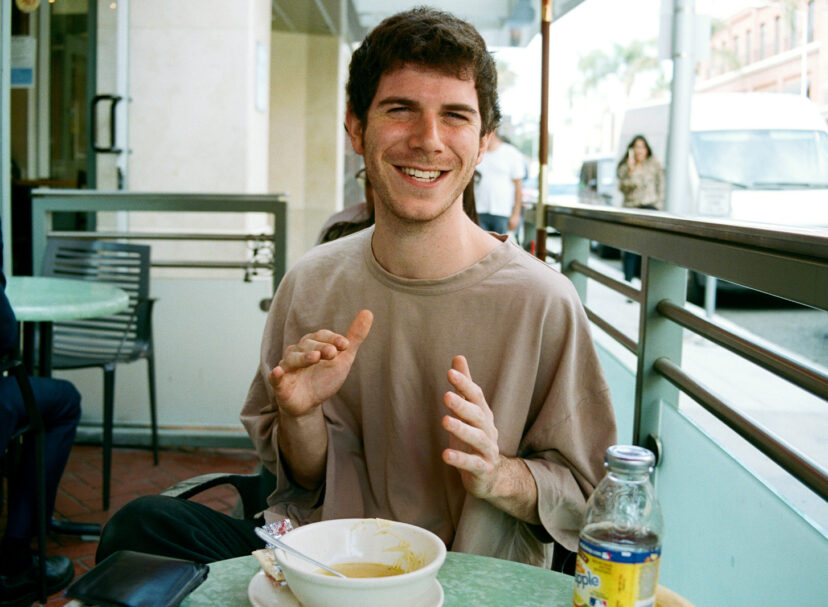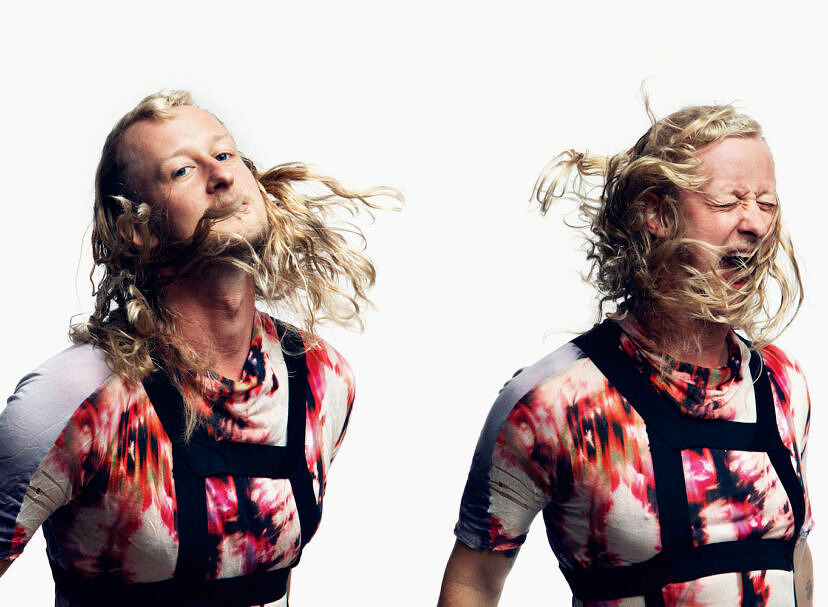Text & Interview: Andy Fenwick
Cover Photo: Darragh Skelton
Photo: Tyler Loring
The obvious road into any writing about Joel Gion begins with his membership in the Brian Jonestown Massacre. Lead by Anton Newcombe, the BJM’s 20+ year-long prolific output of quality psychedelic shoegaze is only rivaled by the inner chaos revealed in the 2004 documentary DIG!, as honest a portrait of band-life as it is a capture of a suddenly dying music industry. DIG! burnished BJM’s offstage reputation, in that they sometimes lived up to their name, in that it mashes up a Rolling Stone found dead in a pool with an infamous mass murder.
As tambourine/maraca player for BJM, Gion was also BJM’s biggest fan, taking on all sorts of non-musical duties. For trivia lovers, his non-BJM duties oddly included a two-episode stint on Gilmore Girls. He was also unfairly maligned at times, but his solo albums, especially his newest s/t effort, should put all that to rest. On his previous effort, 2015’s Apple Bonkers, he had continued to advance into sharply wrought shoegaze pop, but his newest collection tilts away from harder sounds, with some tracks mining the unsung link between tropicalia and shoegaze. If you don’t believe in that link, you’ve never listened to Os Mutantes, to whom bands like Ride, or the Jesus and Mary Chain, owe more than you think.
With the wood blocks, flute and ringing piano on “Come to Light,” and with help from friends from Grails and BJM, Gion also pulls off the difficult trick of psychedelic pop (aka, tropicalia + shoegaze), a move few musicians have achieved in the past 20 years; Paul Weller made an early nineties foray, and recent work by the Clientele come to mind. Like “Come to Light,” most of Gion’s new tracks move upward from a bed of acoustic guitar, often in a smart, less-is-more vein, like the mellotron–sweetened “Gone,” with its perfect guitar solo, or the subtle Bossanova percussion and piano of “Partner.” The overall impact is cinematic, a collection that could easily be transformed into a soundtrack. Here’s wishing Gion’s album finds its own movie.

The atmospheric, pristine-like sound on the new record is really nice; was that the plan going in, or did that come out of the recording process? Did you work differently this time?
The older I get, the harder it becomes to separate cinema and music because I’ve grown to love them equally. Film music – but also, just as important, film imagery – specifically during the late 1950’s up until the late ’70’s, inform my writing and, at this point, are what turn me on to wanting to do it. I can’t live my entire life listening to what twenty-something English guys from the 1960’s had to say at the time. I mean, I can, and certainly will, but I would feel silly trying to do something like that myself at this point. Ennio Morricone in his lush psych jazz mode is big in my house and was probably the main starting point for me this time. I began adding different genres and sounds to what I already did in the “rock” world that normally doesn’t coexist together and that then became an unconscious theme throughout the album writing process. Trying to do what I really wanted to do within the confines of what I was able to do realistically. But hey, that’s everybody’s story in life.
Unlike your other records, this one’s self-titled; any message in that? Or just a ‘here it is’ type thing?
This one is such a pure self-expression of what I’m about musically it seemed like the most fitting title.
The piano works really well on there – who’s playing that? And the flute – that’s a great touch – who’s playing that on a few tracks?
The flute was by Gabriel Cohen. He did such a fantastic job. He’s my only friend that I knew played flute but had I no idea he was so good. I had like an early ’70’s soul groove thing I was trying to mix up and so before his first studio take I explained what I was after and he just nods and then totally takes off into what you hear on “Come to Light.” I was about to fall on the floor and he’s just like “no big deal.” Such a great player.
The piano I wanted, represented throughout, in parts bossa, other parts Morricone-esque, but also at times a sort of Vince Guaraldi thing [editor’s note: tropicalia guitarist Bola Sete was in the Vince Guaraldi Trio] Guaraldi made the Peanuts music and was heavy on the San Francisco jazz scene in the 1960’s and 70’s. San Francisco had a Latin “cool jazz” sound attached to it in general thanks also to Guaraldi and films like Bullitt. My album was recorded in various sessions so there are a few different players representing the different styles. We’ve got Gabriel here again but also Collin Hegna & Rob Campanella (BJM), Nathan Junior (Elliott Smith) and William Slater (Grails) all on there at different sessions.
“Gone” stands out in particular – talk about how that song came about, what it’s about, the delicious guitar figure at 3:10 …
Lyrically it’s about an affluent spinster surrounding herself with illusions to hide how she is in reality perceived by those around her. “Buy everyone a drink because they won’t cry for you sober.” It’s also a ballad to the warnings that come too late. You wake up tomorrow and find everything you love is gone. It’s about America, really. The guitar you mention is one of my favorite moments on the record and actually the only real guitar solo on the entire album. It’s played by Collin Hegna who co-produced and recorded a lot of the record. He’s also one of my best friends and also plays bass in The Brian Jonestown Massacre. This is him making a perfect melodramatic moment that really belongs in a film scene somewhere.
Where do you feel you’re at these days, as a songwriter? Are you itching to begin new work now that this album’s being released? What ideas, on this album, do you want to expand on?
Going from being the maraca player to suddenly writing and recording music was a step-by- step progression that in this age anyone could follow in real time. There’s no way to sweep those first slightly embarrassing efforts under the rug like all of my heroes got to do from when they first started out. But at this point, no one can tell me what’s right or wrong about my music. I know what time it is because it’s mine. On the next record, I’d like to get into some of the big lush arrangements found in parts on this record; to be able to take some of the directions I’m on, here, and go all out with the big budget orchestra and then just fuck with it. It will take a lot of tambourine shaking to come up with the money for that though.
What will be the live set up? Are shows planned?
I have to wait and see what the BJM touring schedule looks like. We are planning to do the world-ly rounds next year, but hopefully, I can work something out around all of that. I wouldn’t skip out on the BJM stuff, there’s room for everything.
Was there any music you had discovered a new, prior to writing or recording?
I already had a good collection of most of the Tropicalia and Bossanova heavy hitters, but then I just went nerd-deep into buying up all the good early ’60’s to mid-’70’s period Brazilian records I could find. It was like being a teenager again.
You got to play tambourine with Ride in 2015 – and it’s been a great few years for fans of shoegaze ‘Mach 1’. Most of the 80s-90s shoegaze reunions are producing new albums of material. Has that been a good thing? Will they keep going like MBV reportedly is, with new work due in 2018?
The shoegaze bands have proven to be the genre of exception when it comes to old groups reforming and just going through the motions. Ride. MBV, Lush, and especially I think Slowdive, who have just put out one of their strongest works. It’s an amazing record! To see a reformed band and think “man, I hope they play a bunch of the new stuff” was an unknown feeling to me, until now.

Are you working on a book?
I am. It’s personal nonfiction that will focus on the period of my moving out on my own for the first time in San Francisco up until a few years later when I literally have to escape the city and move to Portland, Oregon which is pretty much where the documentary film Dig! starts. It’s very much my story, so those looking for the inside scoop on famous friends or bandmates will be disappointed. Mine is the only story I feel I could or am even interested in telling, but those people are a part of that story and of course are in there along with many others whose names will probably need to be changed. The crazy shit some of us do when we are young and totally going for it! Anyway, I know it’s going to be a fun read. It’s about a third of the way finished now.
Is there anything in the music business, right now, that makes you think “wow if BJM had been able to use ____, everything would have been different?” Or, if you don’t even think like that, how does BJM sit within you, now? A closed chapter, an unprocessed thing, a changing thing etc? You’re still together, loosely?
We have a bunch of touring being planned for next year which is really exciting because these past few years are weirdly the best it’s ever been. Those guys are my best friends. Otherwise, the music business is the worst it’s ever been so to answer your question no I’m not envious of anything new in the modern music world, ha-ha. I wish I was. I’m glad we came up when we did.
If I may, a Gilmore Girls question: how did it happen that you appeared on that show (which of course wasn’t so unusual a thing, given GG’s music taste and frequent use of musicians)
Well, the writers were big fans of Dig! so they asked me. I didn’t know at the time Anton was about to ask me to rejoin BJM, so had I known that I don’t think I wouldn’t have done it, but at that moment it was to be a sort of farewell parody for me. Besides, the pitch they used on me was I’d be on the week before Sonic Youth, and I also had friends that loved the show and said I had to do it so I kinda’ just said yes without being familiar with the show. I’m not friends with those people anymore though! Just kidding – I’m not a network T.V. watching kinda’ guy, but having a weirdo like me on a big show for teenagers was a win in itself. It’s pretty obvious in my scenes I’m having a hard time taking it seriously. I was actually scheduled to do a third episode but they suddenly decided that I was just a troublemaker and canceled me. Why it took them so long to figure that out is the mystery!


